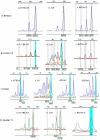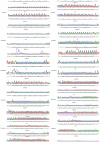Analysis of microsatellite polymorphism in inbred knockout mice
- PMID: 22509320
- PMCID: PMC3324499
- DOI: 10.1371/journal.pone.0034555
Analysis of microsatellite polymorphism in inbred knockout mice
Abstract
Previously, we found that the genotype of 42 out of 198 mouse microsatellite loci, which are distributed among all chromosomes except the Y chromosome, changed from monomorphism to polymorphism (CMP) in a genetically modified inbred mouse strain. In this study, we further examined whether CMP also relates to the homologous recombination in gene knockout (KO) mouse strains. The same 42 microsatellite loci were analyzed by polymerase chain reaction (PCR) in 29 KO inbred mouse strains via short tandem sequence repeat (STR) scanning and direct sequence cloning to justify microsatellite polymorphisms. The C57BL/6J and 129 mouse strains, from which these 29 KO mice were derived, were chosen as the background controls. The results indicated that 10 out of 42 (23.8%) loci showed CMP in some of these mouse strains. Except for the trinucleotide repeat locus of D3Mit22, which had microsatellite CMP in strain number 9, the core sequences of the remaining 41 loci were dinucleotide repeats, and 9 out of 41 (21.95%) showed CMPs among detected mouse strains. However, 11 out of 29 (37.9%) KO mice strains were recognized as having CMPs. The popular dinucleotide motifs in CMP were (TG)(n) (50%, 2/4), followed by (GT)(n) (27.27%, 3/11) and (CA)(n) (23.08%, 3/13). The microsatellite CMP in (CT)(n) and (AG)(n) repeats were 20% (1/5). According to cloning sequencing results, 6 KO mouse strains showed insertions of nucleotides whereas 1 showed a deletion. Furthermore, 2 loci (D13Mit3 and D14Mit102) revealed CMP in 2 strains, and mouse strain number 9 showed CMPs in two loci (D3Mit22 and D13Mit3) simultaneously. Collectively, these results indicated that microsatellite polymorphisms were present in the examined inbred KO mice.
Conflict of interest statement
Figures


Similar articles
-
Detected microsatellite polymorphisms in genetically altered inbred mouse strains.Mol Genet Genomics. 2013 Aug;288(7-8):309-16. doi: 10.1007/s00438-013-0751-y. Epub 2013 May 23. Mol Genet Genomics. 2013. PMID: 23700121
-
Update of mouse microsatellite database of Japan (MMDBJ).Exp Anim. 2004 Apr;53(2):151-4. doi: 10.1538/expanim.53.151. Exp Anim. 2004. PMID: 15153678
-
Novel mouse microsatellites: primer sequences and chromosomal location.DNA Res. 1994;1(4):169-74. doi: 10.1093/dnares/1.4.169. DNA Res. 1994. PMID: 8535974
-
[Analysis on genetic polymorphism of 5 STR loci selected from X chromosome].Zhonghua Yi Xue Yi Chuan Xue Za Zhi. 2005 Feb;22(1):54-7. Zhonghua Yi Xue Yi Chuan Xue Za Zhi. 2005. PMID: 15696480 Chinese.
-
PWD/Ph and PWK/Ph inbred mouse strains of Mus m. musculus subspecies--a valuable resource of phenotypic variations and genomic polymorphisms.Folia Biol (Praha). 2000;46(1):31-41. Folia Biol (Praha). 2000. PMID: 10730880 Review.
Cited by
-
The Genome of C57BL/6J "Eve", the Mother of the Laboratory Mouse Genome Reference Strain.G3 (Bethesda). 2019 Jun 5;9(6):1795-1805. doi: 10.1534/g3.119.400071. G3 (Bethesda). 2019. PMID: 30996023 Free PMC article.
-
Of Men and Mice: Modeling the Fragile X Syndrome.Front Mol Neurosci. 2018 Mar 15;11:41. doi: 10.3389/fnmol.2018.00041. eCollection 2018. Front Mol Neurosci. 2018. PMID: 29599705 Free PMC article.
-
Detected microsatellite polymorphisms in genetically altered inbred mouse strains.Mol Genet Genomics. 2013 Aug;288(7-8):309-16. doi: 10.1007/s00438-013-0751-y. Epub 2013 May 23. Mol Genet Genomics. 2013. PMID: 23700121
-
Mouse cell line authentication.Cytotechnology. 2014 Jan;66(1):133-47. doi: 10.1007/s10616-013-9545-7. Epub 2013 Feb 22. Cytotechnology. 2014. PMID: 23430347 Free PMC article.
-
Bacterial magnetic particles improve testes-mediated transgene efficiency in mice.Drug Deliv. 2017 Nov;24(1):651-659. doi: 10.1080/10717544.2017.1293195. Drug Deliv. 2017. PMID: 28283003 Free PMC article.
References
-
- Weitzmann MN, Woodford KJ, Usdin K. The mouse Ms6-hm hypervariable microsatellite forms a hairpin and two unusual tetraplexes. Journal of Biological Chemistry. 1998;273:30742–30749. - PubMed
-
- Beckmann JS, Weber JL. Survey of human and rat microsatellites. Genomics. 1992;12:627–631. - PubMed
-
- Tautz D, Trick M, Dover GA. Cryptic simplicity in DNA is a major source of genetic variation. Nature. 1986;322:652–656. - PubMed
Publication types
MeSH terms
LinkOut - more resources
Full Text Sources
Molecular Biology Databases
Research Materials
Miscellaneous

